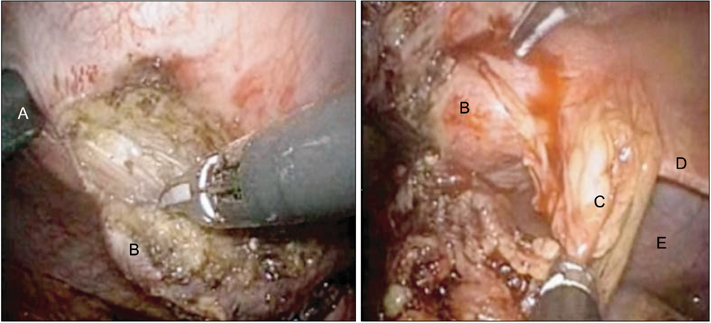Chonnam Med J.
2013 Apr;49(1):43-47. 10.4068/cmj.2013.49.1.43.
Laparoscopic Management of Complicated Urachal Remnants
- Affiliations
-
- 1Department of Urology, School of Medicine, Institute of Wonkwang Medical Science, Wonkwang University, Iksan, Korea. kein917@naver.com
- KMID: 2172176
- DOI: http://doi.org/10.4068/cmj.2013.49.1.43
Abstract
- Managing persistent and symptomatic urachal anomalies requires wide surgical excision of all anomalous tissue with a cuff of bladder tissue via the open approach. We report 7 cases with complete laparoscopic removal of symptomatic urachal remnants with or without a cuff of bladder tissue. We expected that this technique would be less invasive and have lower morbidity. We report on the feasibility of this approach, including efficacy and outcomes. Eight patients with a mean age of 36.5 years who had symptomatic urachal diseases underwent laparoscopic excision between July 2004 and July 2012. With the use of four ports, the urachal remnant was dissected transperitoneally and then removed via the umbilicus port. The clinical results of laparoscopic urachal remnant excision as a minimally invasive surgery, the perioperative records, and pathologic results were evaluated. There were no intraoperative or postoperative complications. Mean surgery time was 2.7 hours. Mean hospital stay was 14.6 days. The patients with bladder cuff resection had a long admission and Foley catheterization period (mean, 14.4 and 11 days). Pathological evaluations were 6 cases of infected urachal cysts, 1 case of infected urachal sinus, and 1 case of urachal adenocarcinoma. We found no postoperative complications including any symptom recurrence or voiding difficulty during a mean follow-up of 46.3 months. The perioperative surgical outcomes achieved infection control and symptomatic relief and additionally good cosmesis. Complete laparoscopic removal of symptomatic urachal remnants with or without a cuff of bladder tissue seems to be a safe, effective, and better cosmetic alternative with the advantages of a minimally invasive approach.
MeSH Terms
Figure
Reference
-
1. Moore KL. The developing human: clinically oriented embryology. 1977. 2nd ed. Philadelfhia: WB Saunders Company;307–309.2. Berman SM, Tolia BM, Laor E, Reid RE, Schweizerhof SP, Freed SZ. Urachal remnants in adults. Urology. 1988. 31:17–21.
Article3. Castillo OA, Vitagliano G, Olivares R, Sanchez-Salas R. Complete excision of urachal cyst by laparoscopic means: a new approach to an uncommon disorder. Arch Esp Urol. 2007. 60:607–611.
Article4. Gopalan A, Sharp DS, Fine SW, Tickoo SK, Herr HW, Reuter VE, et al. Urachal carcinoma: a clinicopathologic analysis of 24 cases with outcome correlation. Am J Surg Pathol. 2009. 33:659–668.5. Bauer SB, Retik AB. Urachal anomalies and related umbilical disorders. Urol Clin North Am. 1978. 5:195–211.
Article6. Scheye T, Vanneuville G, Amara B, Francannet P, Dechelotte P, Campagne D. Anatomic basis of pathology of the urachus. Surg Radiol Anat. 1994. 16:135–141.
Article7. Yiee JH, Garcia N, Baker LA, Barber R, Snodgrass WT, Wilcox DT. A diagnostic algorithm for urachal anomalies. J Pediatr Urol. 2007. 3:500–504.
Article8. Ashley RA, Inman BA, Routh JC, Rohlinger AL, Husmann DA, Kramer SA. Urachal anomalies: a longitudinal study of urachal remnants in children and adults. J Urol. 2007. 178:1615–1618.
Article9. Kim DK, Lee JW, Park SY, Kim YT, Park HY, Lee TY. Initial experience with robotic-assisted laparoscopic partial cystectomy in urachal diseases. Korean J Urol. 2010. 51:318–322.
Article10. Huang CS, Luo CC, Chao HC, Chen HM, Chu SM. Urachal anomalies in children: experience at one institution. Chang Gung Med J. 2003. 26:412–416.11. Cilento BG Jr, Bauer SB, Retik AB, Peters CA, Atala A. Urachal anomalies: defining the best diagnostic modality. Urology. 1998. 52:120–122.
Article12. Little DC, Shah SR, St Peter SD, Calkins CM, Murphy JP, Gatti JM, et al. Urachal anomalies in children: the vanishing relevance of the preoperative voiding cystourethrogram. J Pediatr Surg. 2005. 40:1874–1876.
Article13. Mesrobian HG, Zacharias A, Balcom AH, Cohen RD. Ten years of experience with isolated urachal anomalies in children. J Urol. 1997. 158:1316–1318.
Article14. Trondsen E, Reiertsen O, Rosseland AR. Laparoscopic excision of urachal sinus. Eur J Surg. 1993. 159:127–128.15. Siegel JF, Winfield HN, Valderrama E, Smith AD. Laparoscopic excision of urachal cyst. J Urol. 1994. 151:1631–1633.
Article16. Jorion JL. Laparoscopic removal of urachal cyst. J Urol. 1994. 151:1006–1007.
Article17. Stone NN, Garden RJ, Weber H. Laparoscopic excision of a urachal cyst. Urology. 1995. 45:161–164.
Article18. Fahlenkamp D, Schönberger B, Lindeke A, Loening SA. Laparoscopic excision of the sinusoidal remnants of the urachus in a 3-year-old boy. Br J Urol. 1995. 76:135–137.
Article19. Cadeddu JA, Boyle KE, Fabrizio MD, Schulam PG, Kavoussi LR. Laparoscopic management of urachal cysts in adulthood. J Urol. 2000. 164:1526–1528.
Article20. Khurana S, Borzi PA. Laparoscopic management of complicated urachal disease in children. J Urol. 2002. 168:1526–1528.
Article21. Mesrobian HG, Zacharias A, Balcom AH, Cohen RD. Ten years of experience with isolated urachal anomalies in children. J Urol. 1997. 158:1316–1318.
Article22. Sun J, Zhu YJ, Shi CR, Zhao HT, He R, Liu GH. Laparoscopic radical excision of urachal remnants with recurrent infection in infants. J Endourol. 2010. 24:1329–1332.
Article23. Cutting CW, Hindley RG, Poulsen J. Laparoscopic management of complicated urachal remnants. BJU Int. 2005. 96:1417–1421.
Article24. Araki M, Saika T, Araki D, Kobayashi Y, Uehara S, Watanabe T, et al. Laparoscopic management of complicated urachal remnants in adults. World J Urol. 2012. 30:647–650.
Article25. Jung BJ, Seo JM, Lee SK, Park KH. Urachal anomalies in children: a proper approach and treatment based on the recent ten-year experience. Korean J Urol. 2006. 47:651–655.
Article26. Okegawa T, Odagane A, Nutahara K, Higashihara E. Laparoscopic management of urachal remnants in adulthood. Int J Urol. 2006. 13:1466–1469.
Article27. Turial S, Hueckstaedt T, Schier F, Fahlenkamp D. Laparoscopic treatment of urachal remnants in children. J Urol. 2007. 177:1864–1866.
Article
- Full Text Links
- Actions
-
Cited
- CITED
-
- Close
- Share
- Similar articles
-
- Laparoscopic Excision of Complicated Urachal Cyst in Child
- Laparoscopic Management of Complicated Urachal Remnant in a Child
- A Clinical Study of Urachal Remnants
- Laparoscopic Extraperitoneal Resection of Urachal Cyst
- Infected Urachal Remnants with Symtoms of the Acute Abdomen: The Differential Diagnosis & Proper Management



